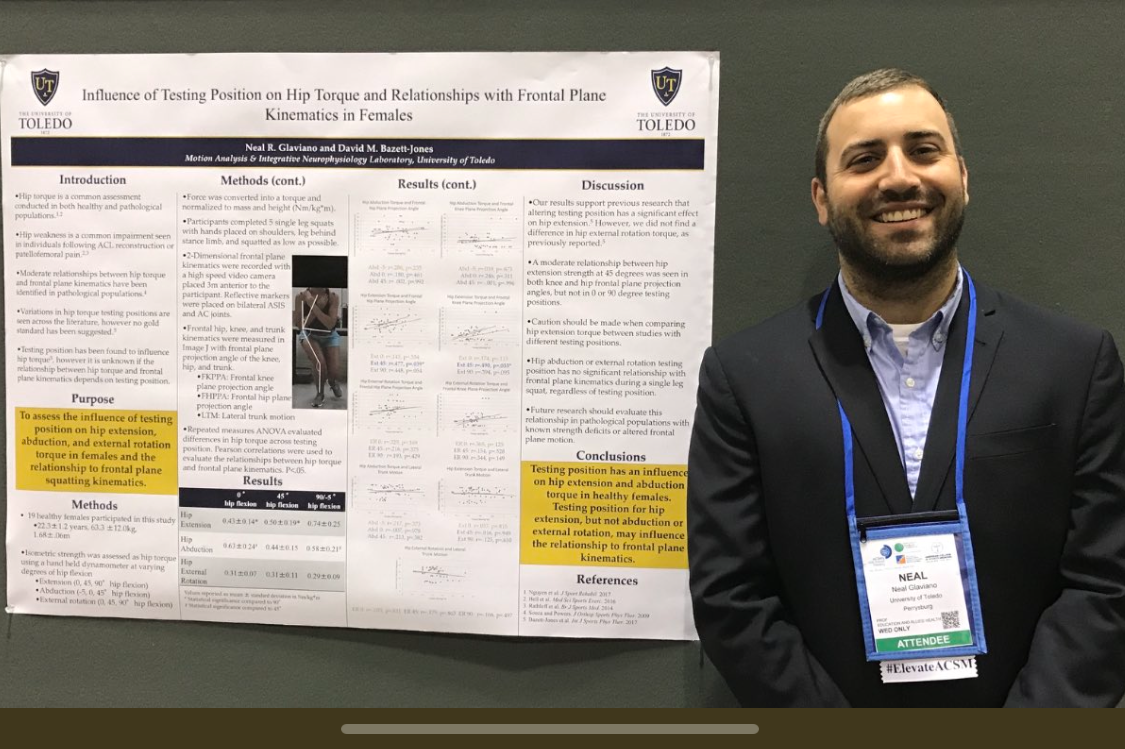The College of Agriculture, Health and Natural Resources’ Department of Kinesiology welcomes new faculty member Neal Glaviano as an assistant professor. He is a 2007 graduate of the department with a bachelor’s degree in athletic training.
“I’m beyond thrilled to be back at UConn where my whole life in athletic training began,” he says. “I look back to my early years at UConn and feel fortunate to have had really good people mentoring us while providing direction and guidance to be the best athletic trainers possible. I want to bring that experience to my students.”
Glaviano first became interested in athletic training during high school when he experienced a rotator cuff tear. During physical therapy, he was asked if he went to the school athletic trainer. He says at that time he didn’t know what an athletic trainer did or that his high school employed one.
He received a master’s degree in athletic training from the University of Virginia (UVA), then returned to Connecticut and worked as a high school athletic trainer. “I wanted to gain clinical experience and see what it was like to be an athletic trainer,” he says. “After four years, I missed conducting research. I wanted to focus on work that would assist clinicians and help patients return to healthy, active lifestyles.”
Glaviano returned to UVA for his Ph.D. in athletic training, for which his research focused on electrical neuromuscular stimulation for patellofemoral pain (kneecap pain). “The research bug hit during my undergraduate studies while working with professor Doug Casa,” Glaviano explains. “Dr. Casa involved students in his research, and I really enjoyed that component. His passion for research was infectious. That inspired me to look at master’s programs with a research component and eventually a Ph.D. program.”
Before accepting a position at UConn, he served as an assistant professor at the University of Toledo College of Health and Human Service, School of Exercise and Rehabilitation Sciences.
Field research led Glaviano to examine electrical stimulation to improve muscle function. “What I noticed in the clinic is that we would treat all ages from children as young as eight years old to patients in their seventies,” he says. “The way clinicians talked to their patients or worked with exercise programs was individualized, yet when it came to using treatments like electrical stimulation, it was the same treatment for everyone. I wanted to learn more about these treatments.”
Electricals stimulation after injury or surgery is designed to promote healing by prompting muscles to contract. “My first couple of projects were focused on using a device to improve how a muscle would fire,” Glaviano says. “It really connected well with patients suffering from patellofemoral pain. I actually experienced that pain myself while running a marathon. Patellofemoral pain is a very prevalent condition, very poorly understood and challenging to treat. We’re seeing up to 60 percent of patients still experience chronic pain after traditional conservative treatment. We’re missing something. That led me to this area of research.”
Glaviano is also looking into a possible association between kneecap pain and weakness in the hips or pelvic muscles referred to as the lumbopelvic-hip complex, more commonly called the “core.”
“We’re seeing patients with weakness in their hips, but that in itself is not a risk factor for patellofemoral pain,” Glaviano notes.
His newest research focuses on seeking a method to quantify altered pelvic muscle function and see how it relates to movement. When the hip muscles are weak, it alters the biomechanics of movement.
“Hip weakness seems to be a consequence of the injury, so we are looking at the biometrics of these people with knee pain to measure the amount of time from the injury to onset of hip weakness. We use electrodes to measure hip muscle function by having a patient perform a hip motion and then use electrostimulation to measure current capability versus the potential of the muscle.”
Glaviano is currently completing a collaborative project with the University of North Florida and the Department of Warfighter Performance at the Naval Health Research Center in San Diego, to study the incidence of knee pain in the military. Glaviano has been a member of the Army National Guard since 2002, so he has a special interest in the men and women serving our country. The team looked at different factors: branches of the military, occupations, male/female, officers versus enlisted members. They hope this informational study will provide data for continued research to develop interventions that minimize risk of injury while increasing military readiness.
Glaviano is teaching a clinical epidemiology course this fall in which students evaluate the effectiveness of treatments or interventions. He says, “When I was a student in the department, we were allowed to make choices and fail and then learn from our mistakes. I can provide students with as much information they are willing to hear, but they have to actually experience what works and what doesn’t and grow from these valuable experiences. That will help them be successful in the future.”



